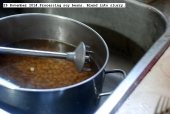My Great-Grandmother would make Cream of Wheat for us. It was a staple. There was no such thing as Captain Crunch or Tony the Tiger. This is breakfast according to someone born in 1896. Her method produced a consistency not unlike vulcanized rubber but we didn't have much back then for comparison. We didn't have maple syrup, or maple flavored syrup, or even honey. There was corn syrup (yuk and it was before GMOs), molasses (good on beans and in cookies, not so much for cream of wheat, come to think of it the beans and cookies weren't all that great either), table sugar (1 spoon, it's expensive!), or blueberry sauce.
The blueberry sauce was close to James Young's
Blueberry Juice. Nannie had around a dozen acres of wild blueberries. We'd harvest half of the field this year, the other half next year. I'm drawing on memories from the 70s and 80s here, but I'd guess she harvested 10 tons of berries each year. A little more when the field behind the house was picked. We'd bring in a bucket of berries, already run through the winnower, and spend much of the evening picking out leaves, bugs, stems, and eating those specimens which were judged to be extremely large or especially promising. I had a blue tongue lasting the entire month of August each year through 1985 when I left for college. BLUE
A good sized pot,
enameled steel with some chips goes up on the stove. She had a
Home Clarion . The berries go in. Pour in just enough water to cover. Add a half a cup of sugar. Not too much, it's expensive. Not like the berries needed added sweetness anyway. Bring the pot to a boil for a minute, just enough to burst the berries so the juice comes out but not so long they turn into mush, then take it off the stove.
While the berries came to a boil she'd ready another pot and some canning jars, and caps, and rubber gaskets. With the berry pot in the sink she could dish up a ladle to fill the jar. Now, you had to work quickly when filling the jars because the berries would make the jar too hot to handle and you had to place the rubber ring and pull down the
wire cage before you burned your fingers. When enough of them were filled she grabbed a towel and moved them the big pot on the stove to boil for a little while. They'd keep until the next harvest down in the sullah. We'd put up a hundred jars this way. She said we could have as much as we want so long as we didnt waste any...

 4
4




 4
4





 1
1




 2
2





 3
3




 3
3








 2
2




 5
5




 3
3




 6
6




 I found resesrch papers that showed if using L. Plantarum starter, it can generate B12 and increase other B vitamins, which can be hard for vegans and some others to get without supplementation.
I found resesrch papers that showed if using L. Plantarum starter, it can generate B12 and increase other B vitamins, which can be hard for vegans and some others to get without supplementation.
 6
6













